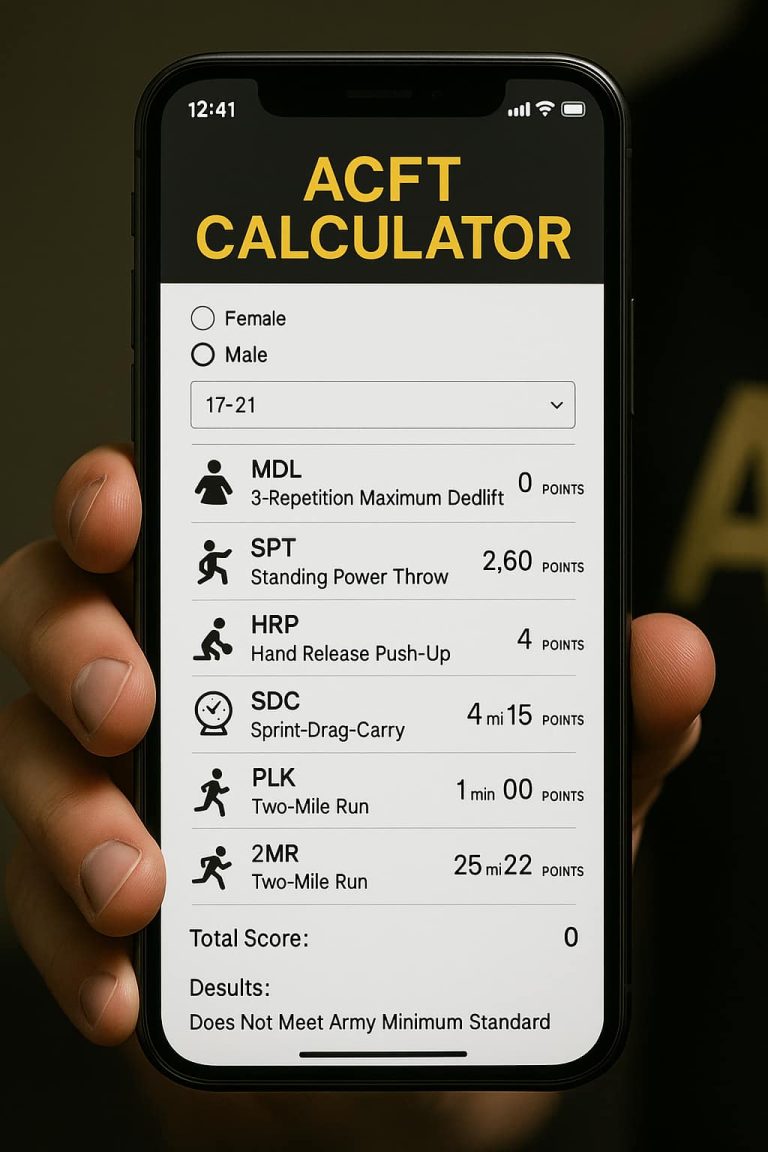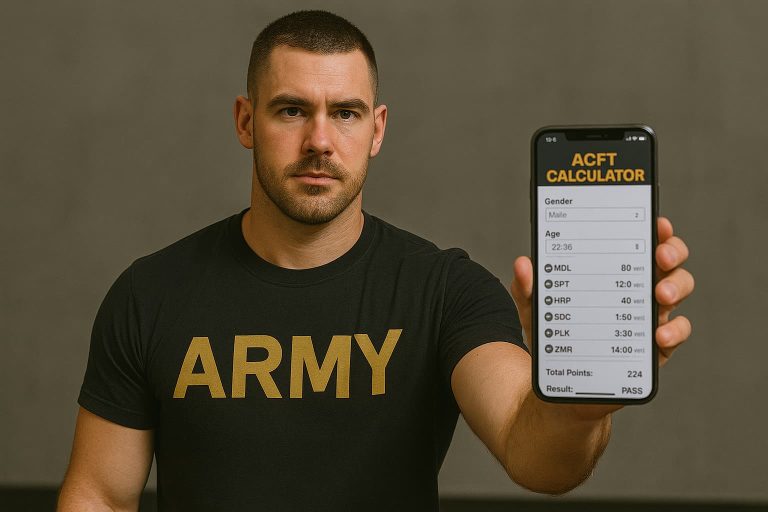10 Must-Do Exercises to Boost Your ACFT Score Fast
Look, I’ve been there – nervous before my first ACFT, wondering if I’d even pass. But I buckled down and focused on these 10 key workouts, and let me tell you — they WORK.
Especially when you pair your training with the ACFT Calculator to track your progress event by event. It was a game-changer seeing my scores improve week after week.
After going from barely passing to crushing it with a 570+ total score, I want to share the exact exercises that got me there.
These aren’t fancy gym moves you’ll never use again. These are battle-tested workouts that directly translate to ACFT success.
10 Must-Do Exercises to Boost Your ACFT Score Fast

Ready to dominate your next test? Let’s dive in.
1. Conventional Deadlifts
Targets: 3-Repetition Maximum Deadlift (MDL)
This one’s obvious but crucial. You can’t fake deadlift strength, and the conventional deadlift is the foundation of everything. I started with just 225 pounds and worked my way up to pulling 350+ for my three reps.
Why it works: It’s literally the same movement pattern as the ACFT event. You’re training your posterior chain, grip strength, and the exact muscle memory you need on test day.
Soldier tip: Focus on form over weight at first. I learned this the hard way after tweaking my back trying to ego-lift. Start with moderate weight, nail your technique, then progressively overload. Your lower back will thank you.
Track your progress: After each deadlift session, plug your max weight into the ACFT Calculator. Watching my MDL points climb from 65 to 95+ kept me motivated during those tough training weeks.
2. Medicine Ball Slams
Targets: Standing Power Throw (SPT)
These explosive movements completely transformed my power throw game. I went from barely hitting 9 meters to consistently throwing over 11.5 meters.
Why it works: Medicine ball slams teach you to generate power from your legs, transfer it through your core, and explode through your arms — exactly what the SPT demands.
Soldier tip: Use a 15-20 pound ball and focus on the triple extension: ankles, knees, and hips all extending explosively at once. Don’t just use your arms — that’s a rookie mistake I made early on.
Track your progress: Every few weeks, test your actual SPT distance and check your score improvement. The calculator showed me that going from 10.2 to 11.5 meters added 15 points to my total — totally worth the effort.
3. Hand-Release Push-Up Variations
Targets: Hand-Release Push-Ups (HRP)
Regular push-ups won’t cut it for the ACFT. You need to train the specific hand-release movement to build the strength and endurance required.
Why it works: By practicing the exact movement pattern, you’re building the specific muscle memory and endurance needed. Plus, the hand-release component eliminates any momentum, making you stronger overall.
Soldier tip: Start with 3 sets of 15-20 reps, focusing on perfect form. Completely lift your hands off the ground at the bottom, then drive up explosively. I used to rush these, but slowing down actually improved my max rep count.
Track your progress: Army Combat Fitness Test your max reps monthly and input the numbers. I was shocked when the calculator showed that improving from 40 to 55 reps boosted my score by 20 points.
4. Farmer’s Walks
Targets: Sprint-Drag-Carry (SDC)
This exercise is an absolute beast for building the grip strength, core stability, and mental toughness needed for the SDC event.
Why it works: Farmer’s walks simulate carrying heavy loads over distance, which directly translates to the kettlebell carries in the SDC. Plus, they build incredible grip strength that helps with the sled drags.
Soldier tip: Use heavy dumbbells or kettlebells (at least 50% of your body weight in each hand) and walk for 40-50 meters. Keep your shoulders back and core tight. Don’t let the weights pull you forward.
Track your progress: Farmer’s walks improve your overall SDC conditioning. Time yourself regularly on practice SDC runs and watch your improvement in the calculator — every 10 seconds faster can mean 5-10 more points.
5. Plank Progressions
Targets: Plank (PLK)
Standard planks are just the beginning. To really crush the plank event, you need progression variations that challenge your core in different ways.
Why it works: Progressive plank variations build the specific core endurance needed to hold proper form for 3+ minutes without shaking apart.
Soldier tip: Start with basic planks, then progress to single-arm planks, plank-to-push-ups, and weighted planks. I hold a 45-pound plate on my back now — makes the test feel easy in comparison.
Track your progress: Test your max plank hold monthly. Going from 2:45 to 4:15 might not seem huge, but the calculator showed me it was worth 25 points — that’s promotion-point gold right there.
6. High-Intensity Interval Training (HIIT)
Targets: Two-Mile Run (2MR) and overall conditioning
HIIT training revolutionized my running and overall ACFT performance. It builds both aerobic and anaerobic capacity, which you need for all six events.
Why it works: The ACFT isn’t just about individual events — it’s about performing all six back-to-back. HIIT prepares your body for sustained high-intensity effort across multiple energy systems.
Soldier tip: Try 400-meter repeats at faster than race pace with 90-second recovery, or 30-second all-out sprints with 90 seconds easy jogging. Mix it up to keep it challenging.
Track your progress: Time your actual two-mile runs regularly. Dropping from 15:30 to 13:45 took months, but seeing the point improvement in real-time kept me grinding through tough workouts.
7. Kettlebell Swings
Targets: Standing Power Throw (SPT) and Sprint-Drag-Carry (SDC)
Kettlebell swings are a powerhouse exercise that builds explosive hip drive and conditioning simultaneously. They’re like a cheat code for ACFT training.
Why it works: The hip hinge movement pattern directly translates to power generation for the SPT, while the high-rep conditioning aspect helps with SDC endurance.
Soldier tip: Focus on driving through your heels and snapping your hips forward explosively. Your arms are just along for the ride — all the power comes from your posterior chain.
Track your progress: Regular kettlebell swing sessions improved both my SPT distance and SDC time. Use the calculator to see how these improvements translate to points — it’s incredibly motivating.
8. Pull-Ups and Chin-Ups
Targets: Hand-Release Push-Ups (HRP) and overall upper body strength
Pull-ups might not be on the ACFT, but they’re crucial for building the balanced upper body strength that makes hand-release push-ups feel easier.
Why it works: Pull-ups strengthen your lats, rhomboids, and rear delts — muscles that support proper push-up form and help prevent shoulder fatigue during high-rep efforts.
Soldier tip: If you can’t do pull-ups yet, use assisted pull-up machines or resistance bands. Focus on controlled movement — no kipping or swinging. Quality over quantity always.
Track your progress: As your pull-up strength improves, you’ll notice your HRP endurance skyrockets. Track your max HRP reps in the calculator and watch the correlation.
9. Battle Ropes
Targets: Sprint-Drag-Carry (SDC) and overall conditioning
Battle ropes are perfect for building the anaerobic conditioning and mental toughness needed to crush the SDC event without completely gassing out.
Why it works: The continuous wave motion builds incredible conditioning while strengthening your grip, core, and shoulders — all crucial for the SDC’s various movements.
Soldier tip: Start with 30-second intervals and build up to 2-minute continuous efforts. Keep the waves consistent and don’t let them die out — that’s where the real conditioning benefit comes from.
Track your progress: Better conditioning from battle ropes directly improves your SDC times. Every 15-second improvement in your SDC can boost your score significantly — check the calculator to see exactly how much.
10. Burpees
Targets: Overall ACFT conditioning and mental toughness
Burpees are the exercise everyone loves to hate, but they’re incredibly effective for building the full-body conditioning and mental resilience needed for ACFT success.
Why it works: Burpees combine strength, cardio, and the ability to get up and down quickly — skills that directly transfer to multiple ACFT events, especially when you’re fatigued.
Soldier tip: Focus on smooth, controlled movement rather than speed. A good burpee includes a full push-up at the bottom and a jump at the top. Don’t half-rep these — you’re only cheating yourself.
Track your progress: Regular burpee sessions improve your overall conditioning, which helps every ACFT event. Use the calculator to track your total score improvements as your overall fitness level increases.
Putting It All Together
Here’s the thing – you don’t need to do all 10 exercises every day. That’s a recipe for burnout and injury. Instead, focus on 3-4 exercises per session, rotating through them throughout the week.
I typically organized my training like this:
- Monday: Deadlifts + Medicine Ball Slams + Plank Progressions
- Wednesday: Hand-Release Push-Ups + Farmer’s Walks + HIIT Running
- Friday: Kettlebell Swings + Pull-Ups + Battle Ropes + Burpees
The key is consistency and progressive overload. Start where you are, not where you think you should be, and gradually increase intensity over time.
Your Secret Weapon: The ACFT Calculator
Throughout my training journey, the ACFT Calculator was my constant companion. After every workout and practice test, I’d plug in my numbers to see exactly where I stood.
The real magic happened when I could experiment with “what if” scenarios. Want to know how much improving your deadlift by 20 pounds would help your total score? Just adjust the number and see instantly. It helped me prioritize my training time and energy on the exercises that would give me the biggest score improvements.
Plus, watching my total score climb from 425 to 570+ over six months was incredibly motivating. Some weeks the improvements were small, but seeing steady progress kept me pushing forward.
The Bottom Line
Look, the ACFT isn’t going anywhere, and your score directly impacts your military career. These 10 exercises aren’t magic – they’re just proven methods that work when you put in the effort consistently.
Start with these exercises, track your progress religiously, and stay patient with the process. Some weeks you’ll feel like you’re not improving, but trust me — consistency always pays off.
Remember: every soldier who’s crushed the ACFT started somewhere. The difference between those who succeed and those who struggle isn’t natural talent — it’s having the right plan and sticking to it.
Ready to Dominate Your ACFT?
Pick 3-4 exercises from this list and start incorporating them into your training this week.
Use the ACFT Calculator to establish your baseline, set specific goals for each event, and track your improvement along the way.
Your future self (and your promotion points) will thank you for starting today. Now stop reading and get to work — those ACFT points won’t earn themselves!
Trust me, if I can go from barely passing to crushing the test, you can too. The tools are here, the plan is solid — now it’s just about execution.
Get after it, soldier!





